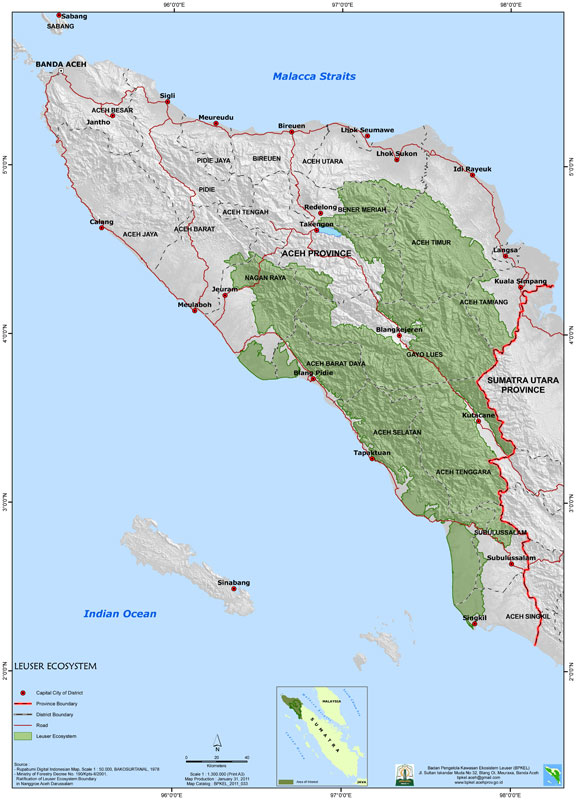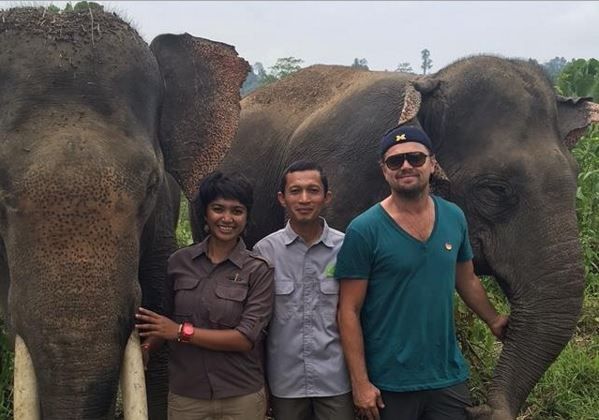- Deforestation in Indonesia’s Aceh province last year fell 18 percent from 2016 — a trend activists attribute to better law enforcement and intensified campaigning about the importance of protecting the unique Leuser Ecosystem.
- Another factor is a government moratorium on oil palm planters clearing peatlands, but this hasn’t stopped many such operators from acting with impunity.
- Activists worry that future threats will come from road projects and planned hydropower and geothermal plants.
ACEH, Indonesia — Deforestation slowed last year in the Indonesian province of Aceh, home to the Leuser Ecosystem biodiversity hotspot, according to a local forest watchdog.
The province, which spans 58,377 square kilometers (22,539 square miles) on the northern tip of the island of Sumatra, lost 173 square kilometers (67 square miles) of forest in 2017, according to data from the group Forest, Nature and Environment of Aceh (HAkA). That was down nearly 18 percent from area of forest lost in each of the past two years.
Much of the slowdown in deforestation was recorded within the Leuser Ecosystem, one of Indonesia’s last large tracts of intact rainforest, which is home to four of the most iconic and critically endangered species on Earth: the Sumatran tiger, rhino, orangutan and elephant.
Some 87 percent of the Leuser ecosystem, which spans more than 26,000 square kilometers (10,040 square miles) lies inside Aceh, and the rest in North Sumatra province.
Agung Dwinurcahya of HAkA attributed the decline to better law enforcement and intensifying campaigns to protect the endangered ecosystem.
“NGOs’ efforts on the ground and their cooperation with the government, such as through the Integrated Forest Management [KPH] unit and law enforcers, seem to have been effective in slowing down the deforestation rate,” he told Mongabay. “We’ve seen an increase in public awareness as well, especially within the Leuser Ecosystem, as we see the deforestation there declining every year.”
In 2017, HAkA recorded the lowest rate of deforestation within the Leuser Ecosystem in three years, amounting to nearly 69 square kilometers (27 square miles) of forest cleared, down 34 percent from 2016 and 50 percent from 2016.
HAkA focuses its monitoring on Leuser as the entire ecosystem is under threat from the expansion of oil palm and pulpwood plantations, as well as logging and mining operations. A core part of the ecosystem, designated the Gunung Leuser National Park, enjoys strict protections, but covers just 3,210 square kilometers (1,240 square miles). Much of the rest of the ecosystem, including its ecologically important lowland forests and peat swamps, is ostensibly open to development under the provincial government’s land-use plans.
The government has acknowledged these issues, though, and in 2016 declared a ban on clearing forests for oil palm plantations, in a bid to protect lowland forests in the Leuser Ecosystem. The moratorium was cemented via a memo ordering all palm oil firms to stop clearing forest, even if they already had licenses, pending a review of those permits.
Agung said the moratorium might have contributed to the slowdown in the deforestation rate. But some companies continue to slash away at the critical ecosystem, in clear defiance of the ban.
“Clearing is no longer allowed within oil palm plantations in the Leuser Ecosystem, but there are still some plantations that don’t manage their concessions well, so clearing is still happening on a large scale in East Aceh [district] and the Tripa peat swamp forest,” he said.

Tripa threat
The Tripa peatland, a part of the Leuser Ecosystem, is home to the world’s densest population of Sumatran orangutans. Large tracts of the peatland have been badly damaged by rogue oil palm plantation operators and illegal loggers. Hunting and poaching of wildlife is also an issue, as are human-animal conflicts and fires.
In 2012, palm oil company PT Kallista Alam lit fires to clear forested areas in Tripa, prompting the government to take it to court. In 2015, the country’s highest court ordered the company to pay 366 billion rupiah ($25.6 million) in fines and reparations for burning 10 square kilometers (3.9 square miles) of land.
Law enforcement officials and conservation activists hailed the ruling as a deterrent for other companies planning similar destructive activities in the Tripa area. To date, however, Kallista Alam has still not paid the money, and is suing the government for submitting what it says were misleading coordinates in the original complaint.
Meanwhile, deforestation continues apace in the company’s concession. Twelve hectares (30 acres) of land were cleared inside the plot in the peat swamp between Aug. 21 and Sept. 13 last year, according to satellite monitoring by the Rainforest Action Network (RAN), a U.S.-based advocacy group.
It also showed ongoing deforestation inside the concession of another palm planter, PT Surya Panen Subur (SPS) II, since June 2016, totaling 2.28 square kilometers (0.8 square miles) of forest loss.
SPS II is the third palm oil firm with a concession in Tripa that has been taken to court by the government for using fire to clear land. But unlike Kallista Alam, SPS II was cleared by the Supreme Court in 2016, with the judges ruling that the government, in this case the Ministry of Environment and Forestry, was unable to prove that the peat swamp inside the concession was damaged.

Roads and energy
Besides the immediate threat of deforestation from plantation operators, activists are worried about the impact to the Leuser Ecosystem from a host of ambitious infrastructure development plans.
“Based on our observation, the thing that poses the biggest threat to forests in Aceh and the Leuser Ecosystem is road development,” said HAkA’s Agung.
In 2017 alone, some 440 kilometers (273 miles) of roadway were built across the Leuser Ecosystem, according to the Leuser Conservation Forum (FKL), a local NGO. Hundreds more kilometers are planned, including through Mount Leuser National Park. With paved road slicing through highly sensitive areas of the ecosystem, conservationists worry that encroachment and habitat loss are inevitable.
But proponents of the project say it serves to connect isolated villages and spur economic activity in Aceh province, which remains underdeveloped as a result of decades of separatist conflict and the devastation wrought by the 2004 Indian Ocean tsunami.
Another concern is the plan to develop hydropower dams, Agung said. At least two dams have been proposed for the Leuser area: one, in Gayo Lues district, will have a 428-megawatt power plant; the other, in the Kluet peatland of South Aceh district, will power a 180-megawatt turbine.
“And then there’s also a plan to develop a cement factory and a mine by PT Tripa Semen Aceh in Aceh Tamiang district,” Agung said. Activists say the cement plant will exacerbate Aceh Tamiang’s water problems by putting pressure on the locals’ water supply.
There are also fears that forest fires will make a comeback this year, after flaring up in parts of Aceh last year. Those fires razed peat forests in the districts of West Aceh, Aceh Jaya, Tripa and South Aceh, according to the Indonesian Forum for the Environment (Walhi), the country’s biggest environmental advocacy NGO.
“The fires happened because of illegal clearing for plantations,” said Muhammad Nur, director of Walhi’s Aceh chapter. “We haven’t seen law enforcement action against these environmental crimes.”
Agung said it was important for the Leuser Ecosystem to be considered in the provincial zoning plan, passed in 2013, for it to be protected. Because of its omission from the plan, however, the area is open to exploitation. (The central government currently recognizes the Leuser Ecosystem as a protected area. But under Indonesia’s decentralized system of governance, final authority for local land management falls under the remit of provincial and district officials.)
Officials in Aceh — which enjoys even greater autonomy than other provinces, thanks to concessions made to rebels to end their secessionist struggle in 2005 — argue that they have every right to develop the area for the economic welfare of the people.
The current governor of Aceh, Irwandi Yusuf, has since his inauguration last year indicated that he wants to protect the Leuser Ecosystem, Agung said. He stopped a project to build a geothermal power plant in the ecosystem and relocated it elsewhere in a bid to protect the environment.
“We have high hopes for the new governor,” he said. “But we haven’t seen any concrete action [toward ensuring systematic protections for the ecosystem]. Will he include the Leuser Ecosystem in the province’s zoning plan?”
Banner image: A captive Sumatran tiger. The species still live in the wild in the Aceh’s Leuser Ecosystem. Photo by Rhett A. Butler/Mongabay.
